

John H. Walton, Ancient Near Eastern Thought and the Old Testament: Introducing the Conceptual World of the Hebrew Bible (2nd edition, 2018)
Book Review: Ancient Near Eastern Thought and the Old Testament explores the cultural and intellectual context of the ancient Near East (ANE) to enhance an essential understanding of the Old Testament’s historical context. Walton examines various aspects of ANE thought, including cosmology, mythology, and societal norms, and compares them with biblical texts. The book aims to provide readers with a deeper appreciation of how the Old Testament writers engaged with and differentiated themselves from the surrounding cultures.
One of the book’s strengths is the affirmation of the Bible’s uniqueness while acknowledging its interaction with ANE cultures. Walton carefully navigates the relationship between the Bible and its surrounding environment, underscoring that while there are similarities, the biblical texts maintain distinct theological and moral perspectives. Walton’s discussion on cosmology and mythology is particularly enlightening. He demonstrates how the Old Testament writers used familiar ANE concepts but redefined them to convey unique theological truths about God, creation, and humanity. Moreover, the writing style is both deeply scholarly yet understandable for a broader audience, bridging the gap between ancient peoples and modern faith practices. Thus, this book is a valuable resource for anyone seeking to deepen their understanding of the Old Testament. Despite these benefits, the second edition does change on the topic of imitating God. The second edition indicates Walton apparently shifted in his thinking over the years. Still, the overall benefit of Walton’s insights into the world of the Bible is helpful despite this unfortunate shift.
Here are a few helpful contributions of the book:
1. Cultural Context: Walton emphasizes the importance of understanding the cultural and intellectual context of the ANE for interpreting its texts accurately, recognizing that the Bible was written within a specific cultural setting.
2. Comparative Approach: This approach examines similarities and differences between the Old Testament and other ANE texts. Walton explores how the biblical authors interacted with the surrounding cultures, sometimes adopting, adapting, or rejecting their ideas.
3. Cosmology and Mythology: Walton explains how the worldviews of the ANE influenced the biblical understanding of creation, the cosmos, and divine beings. This background helps modern readers see how the Bible presents a unique theological perspective from those of the time yet distinct from the modern reader.
4. Law and Society: The book compares biblical laws and societal norms with those of other ANE cultures, such as the Code of Hammurabi. Understanding these parallels and distinctions highlights the distinctiveness of biblical ethics and social practices.
5. Divine Revelation: Walton discusses the concept of divine revelation in the ANE, contrasting it with the biblical view. This comparison underscores the unique way in which the Bible presents God's interaction with humanity.
6. Genre and Literary Forms: The book addresses various literary genres and forms found in the ANE and the Old Testament, such as epics, hymns, and legal codes. Recognizing these forms aids in understanding the structure and purpose of biblical texts.
7. Purpose of the Old Testament: Walton emphasizes that the Old Testament is not just a historical document but a theological text with a purpose. The biblical authors used ANE cultural concepts to communicate profound theological truths about God, humanity, and the world.






